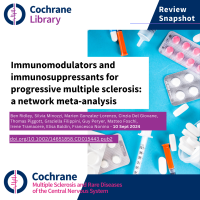
We are excited to announce the publication of our latest network meta-analysis, "Immunomodulators and Immunosuppressants for Progressive Multiple Sclerosis", now available in the Cochrane Library.
This comprehensive study explores the comparative efficacy and safety of several immunomodulatory and immunosuppressive treatments for progressive multiple sclerosis (PMS).
Here's you can find the Plain Language Summary as reported by the authors:
What are the benefits and risks of different treatments that could delay or slow the progression of progressive multiple sclerosis?
- Overall, we are very uncertain about the effects of treatments on relapses and slowing the worsening of disability. We did find evidence that rituximab after two years and interferon beta‐1b after three years of treatment probably slightly reduce the number of people who experience relapses.
- The number of people who stop taking a drug because of harmful events is slightly higher with interferon beta‐1a, and probably slightly higher with interferon beta‐1b, rituximab, immunoglobulins, glatiramer acetate, natalizumab, fingolimod, siponimod, and ocrelizumab.
- Longer studies that make comparisons between treatments are needed to assess the benefits and harms of drugs acting on the immune system over time for people with progressive multiple sclerosis. Future studies should also consider other effects that are important to people with progressive multiple sclerosis, such as quality of life and ability to think, learn, remember, use judgement, and make decisions.
Background
Multiple sclerosis is caused by inflammation of the brain and spine due to an impairment of the immune system, resulting in damage that gradually limits activities of daily living. People with multiple sclerosis typically experience tiredness, pain, cramps in their muscles, and reduction or loss of sensitivity and strength in parts of their body. The appearance of symptoms is called 'relapse', and is usually followed by gradual recovery ('remission'), in what is known as 'relapsing‐remitting' multiple sclerosis. When recovery doesn't happen or is incomplete between relapses, it is known as 'progressive' multiple sclerosis.
Over the years, in most people with relapsing‐remitting multiple sclerosis, worsening of disability will become continuous, without recovery. This is known as 'secondary‐progressive' multiple sclerosis. In about 15 out of 100 cases, multiple sclerosis shows a progressive course from the onset, without relapse and recovery. This is called 'primary progressive' multiple sclerosis.
Multiple sclerosis affects males and females in equal proportion, with onset occurring most often between the ages of 30 and 50 years.
How is multiple sclerosis treated?
What did we want to find out?
• which treatments produce the most benefit, in terms of the number of people with a reduction of relapses or disability worsening; and
• if any drug is better tolerated than any other drug or causes fewer unwanted effects.
What did we do?
What did we find?
- We are confident that slightly more people stop taking interferon beta‐1a because of unwanted effects when compared to placebo.
- We are moderately confident that rituximab after two years and interferon beta‐1b after three years of treatment slightly reduce the number of people with relapses, and slightly more people stop taking interferon beta‐1b, rituximab, immunoglobulins, glatiramer acetate, natalizumab, fingolimod, siponimod, and ocrelizumab because of unwanted effects, when compared to placebo.
- We are very uncertain about the effect of the other treatments studied on number of people with relapses, number of people with a worsening of disability, number of people who stop taking the drug because of unwanted effects, and number of people with serious unwanted effects.
What are the limitations of the evidence?
Our confidence in the effects of disease‐modifying drugs is very limited because the evidence was based on relatively low numbers of people experiencing events like relapses and worsening of disability, and because we were concerned that the interests of drug companies may have influenced the reporting of results.
How up‐to‐date is this evidence?
The evidence is current to 8 August 2022.
